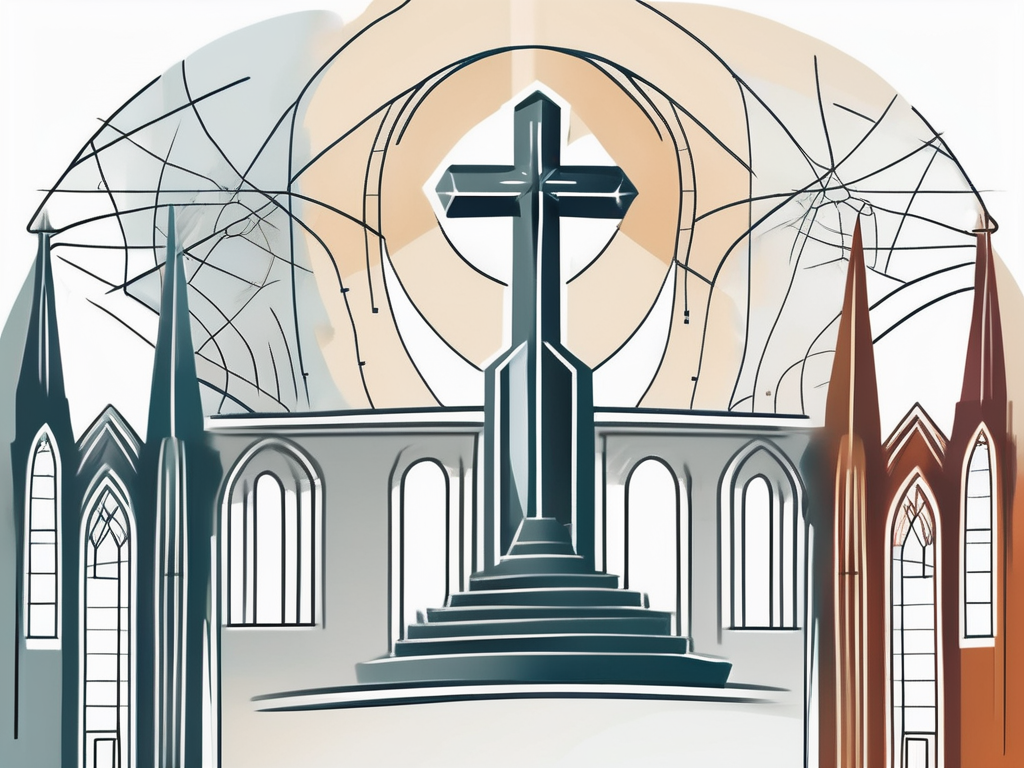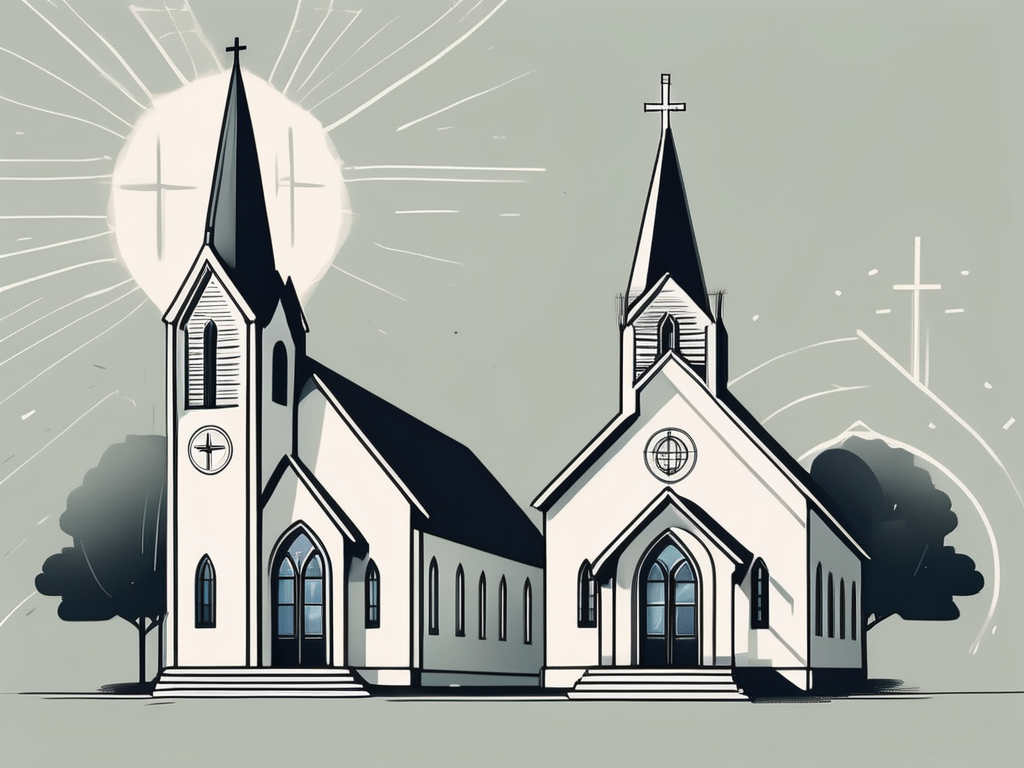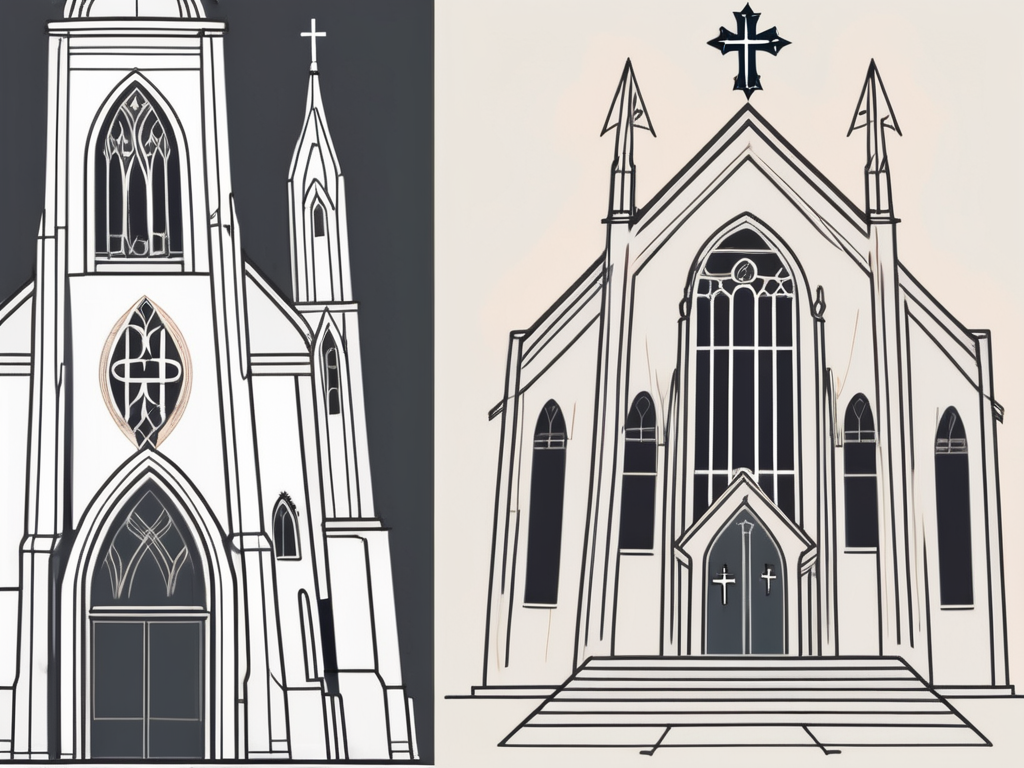When it comes to beliefs and practices in Christianity, there is a broad spectrum of denominations, each with its own unique characteristics and traditions. In this article, we will delve into the similarities and differences between Methodism and Lutheranism, two prominent Protestant denominations. By understanding their origins, core beliefs, worship styles, sacraments, and church governance, we can gain valuable insights into these faiths and appreciate their distinctive approaches to spirituality.
Understanding the Origins of Methodism and Lutheranism
The Founding Principles of Methodism
Methodism originated in the 18th century as a movement within the Church of England. Its founder, John Wesley, sought to revive passionate and practical Christianity. Wesley’s preaching emphasized personal religious experience, individual transformation, and acts of love and compassion.
Wesley’s passion for spreading the Gospel led him to travel extensively, preaching to large crowds in open fields and marketplaces. He believed that faith should not be confined to the walls of a church but should be shared with all people, regardless of their social status or background.
One of the defining characteristics of Methodism is its emphasis on the importance of small group meetings, known as “class meetings” or “societies.” These gatherings provided a space for members to share their spiritual experiences, offer support and accountability, and engage in acts of service to the community.
The Birth of Lutheranism
Lutheranism traces its roots back to the 16th-century Reformation led by Martin Luther in Germany. Luther, a Catholic priest, challenged the prevailing practices of the Church and sought to bring about change based on his interpretation of Scripture. His teachings emphasized salvation by faith alone, divine grace, and the authority of the Bible.
Luther’s bold actions, such as nailing his Ninety-Five Theses to the door of the Castle Church in Wittenberg, sparked a theological and social revolution. His writings, including the translation of the Bible into German, enabled ordinary people to access and understand the Scriptures, empowering them to question the teachings of the Church.
As Lutheranism spread across Europe, it became closely intertwined with the political and social landscape of the time. The movement gained support from various rulers who saw Luther’s ideas as an opportunity to challenge the authority of the Catholic Church and consolidate their own power.
Lutherans regard baptism as the means through which individuals are united with Christ, and they affirm the doctrine of “justification by faith,” which emphasizes that salvation is a free gift from God, received through faith rather than earned through good works. This belief in salvation by faith alone brought a sense of liberation and assurance to many who had previously felt burdened by the idea of earning their salvation through their own efforts.
Core Beliefs and Doctrines
Fundamental Beliefs of Methodism
Methodists believe in the Trinity – the Father, Son, and Holy Spirit – as one God in three persons. This belief is rooted in the understanding that God is a relational being, existing eternally in perfect unity and community. Methodists affirm Jesus Christ as the Son of God and the Savior of humanity, emphasizing his role in reconciling humanity to God through his life, death, and resurrection.
Methodism places great importance on the Bible as the primary source of faith and practice. Methodists believe that the Bible contains the inspired word of God, revealing God’s character, will, and plan for humanity. However, they also recognize the need for interpretation, guided by tradition, reason, and experience. These additional sources of authority help Methodists engage with the biblical text in a way that is relevant to their lives and the world they live in.
Methodists also emphasize the concept of social justice and actively engage in works of compassion and mercy. Inspired by Jesus’ teachings and example, Methodists seek to alleviate poverty, promote equality, and advocate for the marginalized. They believe that faith is not just a personal matter, but should be lived out in the world, making a positive difference in society.
Key Doctrines of Lutheranism
Like Methodists, Lutherans adhere to the doctrine of the Trinity and proclaim Jesus Christ as Lord and Savior. They affirm the importance of the Bible as the authoritative Word of God, recognizing it as the ultimate source of truth and guidance for faith and life. Lutherans believe that through the Bible, God reveals his will and offers the gift of salvation to all people.
For Lutherans, the concept of “grace alone” holds significant importance. They believe that salvation is a gift of God’s grace received through faith, rather than something that can be earned through good works or personal merit. This emphasis on grace highlights the Lutheran understanding of humanity’s complete dependence on God for salvation.
Additionally, Lutherans observe the sacraments of baptism and the Eucharist as means of grace. Baptism is seen as a sacrament of initiation, marking the beginning of a person’s Christian journey and symbolizing their incorporation into the body of Christ, the Church. The Eucharist, also known as Holy Communion, is understood as a sacrament of nourishment, where believers partake in the body and blood of Christ, receiving God’s presence and forgiveness.
Through these sacraments, Lutherans believe that God’s grace is made tangible and accessible to believers, strengthening their faith and deepening their relationship with God.
Worship Styles and Practices
Worship in the Methodist Tradition
Methodist worship services often combine elements of formal liturgy, hymn-singing, prayers, and sermons. The focus is on fostering a sense of community and active participation. Music, both traditional hymns and contemporary songs, plays a central role in Methodist worship, expressing praise and facilitating spiritual reflection.
Methodists believe that worship is an opportunity to encounter God’s presence and experience spiritual transformation. They value heartfelt expressions of worship, personal testimonies, and the power of congregational prayer.
Within the Methodist tradition, there is a rich history of hymnody. Charles Wesley, one of the founders of Methodism, wrote thousands of hymns that are still sung today. These hymns are filled with theological depth and emotional resonance, providing a powerful means of connecting with God and expressing faith.
In addition to music, Methodist worship services often include liturgical elements such as responsive readings, where the congregation participates in the reading of Scripture or prayers. This practice helps to engage the entire community in the act of worship, creating a sense of unity and shared purpose.
Methodists also place a strong emphasis on social justice and service to others. This commitment is often reflected in their worship practices, with opportunities for congregants to engage in acts of compassion and outreach as part of the worship experience.
Lutheran Worship Practices
Lutheran worship services generally follow a more structured format, often including elements such as organ music, liturgical prayers, creeds, and responsive readings of Scripture. Lutherans place high value on the proclamation of God’s Word through preaching, which is typically a central part of their worship gatherings.
Lutheran worship focuses on the sacraments, particularly the Holy Communion. Believers view the Eucharist as a means of receiving the true presence of Christ, where forgiveness is bestowed and faith is strengthened.
The use of organ music in Lutheran worship is deeply rooted in tradition. The majestic sound of the organ fills the sanctuary, creating an atmosphere of reverence and awe. The organ’s rich tones and intricate melodies enhance the worship experience, inviting worshippers to enter into a sacred space.
Another distinctive feature of Lutheran worship is the inclusion of liturgical prayers. These prayers, often recited by the entire congregation, provide a framework for worship and express the collective faith of the community. The use of liturgical prayers helps to connect Lutherans to the broader historical and global Church, reminding them that they are part of a larger body of believers.
Lutherans also place a strong emphasis on the importance of Scripture in worship. Responsive readings of Scripture allow the congregation to actively engage with God’s Word, reinforcing the belief that the Bible is a living and relevant guide for faith and life.
Furthermore, Lutheran worship services often incorporate the use of symbols and rituals. These visual and tactile elements serve as reminders of the central tenets of the faith and help to deepen the worship experience. Examples of such symbols include the cross, baptismal font, and candles.
Sacraments and Rituals
Sacraments in Methodism
Methodism, a branch of Christianity that emerged in the 18th century, recognizes two sacraments: baptism and Holy Communion. These sacraments hold great significance in the Methodist tradition, symbolizing key aspects of the Christian faith.
Baptism, the first sacrament, signifies entry into the Christian community. It is a sacred ritual that is often performed through sprinkling, pouring, or immersion, depending on the individual’s preference and the practices of the specific Methodist congregation. The act of baptism represents the washing away of sin and the beginning of a new life in Christ.
Holy Communion, also known as the Lord’s Supper or Eucharist, is the second sacrament in Methodism. It is a sacred meal shared among believers in remembrance of Christ’s sacrifice on the cross. During this ritual, bread and wine (or grape juice) are consecrated and distributed to the congregation. Methodists believe in the real presence of Christ in the elements, and partaking in Holy Communion is seen as a means of receiving spiritual nourishment and deepening one’s relationship with God.
While baptism and Holy Communion are the only sacraments officially recognized in Methodism, there are other religious practices that hold special significance in the Methodist tradition. These practices, though not considered sacraments, represent important milestones in the spiritual journey of individuals.
Confirmation, for example, is a rite of passage where individuals publicly affirm their faith and commitment to the Christian community. It is often preceded by a period of study and preparation, during which individuals deepen their understanding of the Methodist beliefs and practices. Confirmation serves as a personal affirmation of one’s faith and a recognition of the presence of the Holy Spirit in one’s life.
Marriage is another significant religious practice in Methodism. It is viewed as a sacred covenant between a man and a woman, blessed by God and witnessed by the Christian community. Methodist weddings often include prayers, scripture readings, and the exchange of vows, symbolizing the couple’s commitment to love, honor, and support each other in accordance with Christian teachings.
Ordination, on the other hand, is a ritual that sets individuals apart for specific roles of leadership within the Methodist Church. It is a solemn ceremony where individuals are ordained as deacons or elders, signifying their calling to serve and minister to the congregation. The ordination process involves theological education, examination, and the laying on of hands by ordained clergy, symbolizing the passing on of spiritual authority.
The Role of Rituals in Lutheranism
Lutheranism, a Christian denomination that traces its roots back to the Protestant Reformation led by Martin Luther in the 16th century, also places great importance on sacraments and rituals in its worship practices.
Similar to Methodism, Lutheranism recognizes two primary sacraments: baptism and Holy Communion. These sacraments are considered essential for the spiritual growth and nourishment of believers.
Baptism, in the Lutheran tradition, is viewed as a sacrament that unites the believer with Christ and marks their incorporation into the Church. It is seen as a means of grace, where God’s love and forgiveness are extended to the individual. Lutherans practice baptism through sprinkling, pouring, or immersion, and it is often performed during infancy as a sign of God’s unconditional love and acceptance.
Holy Communion, also known as the Lord’s Supper, is another sacrament that holds deep significance in Lutheranism. Lutherans believe in the real presence of Christ in the bread and wine (or grape juice) used during the ritual. Through the act of Holy Communion, believers partake in the forgiveness of sins and experience a spiritual union with Christ and fellow believers.
In addition to sacraments, Lutheran worship incorporates various rituals that enhance the worship experience and provide a visual and sensory connection to the theological truths they represent. These rituals are not considered sacraments but are an integral part of Lutheran worship practices.
The sign of the cross, for example, is a ritual gesture that is often made by Lutherans during worship. It is a physical representation of the crucifixion of Christ and a reminder of the believer’s identity as a follower of Christ. The act of making the sign of the cross can serve as a personal expression of faith and a way to seek God’s blessing and protection.
Lutheran worship also includes the use of liturgical vestments, which are special garments worn by clergy and other worship leaders. These vestments, such as robes, stoles, and chasubles, have symbolic meanings and help create a sense of reverence and distinction during worship. They serve as visual reminders of the sacredness of the worship space and the roles of those leading the congregation in worship.
Another ritual commonly observed in Lutheran worship is the lighting of candles. Candles are often placed on the altar or around the worship space and are lit as a symbol of Christ’s presence and the light of God’s love shining in the world. Lighting candles can create a peaceful and contemplative atmosphere, inviting worshippers to reflect on their faith and offer prayers and petitions to God.
These rituals, along with the sacraments of baptism and Holy Communion, play a vital role in Lutheran worship, providing believers with opportunities to engage their senses, deepen their spiritual connection, and express their faith in tangible ways.
Church Governance and Structure
The Methodist Church Hierarchy
The Methodist Church operates under a connectional system, with a hierarchy that includes local churches, districts, conferences, and the General Conference. Methodist churches are often led by ordained ministers, and decision-making is carried out through a combination of clergy and lay involvement.
This structure allows for a flexible and cooperative approach to governance, where churches are connected and work together to fulfill the mission of the Church.
Structure of the Lutheran Church
Lutheranism typically follows a congregational structure, meaning that individual congregations have a significant level of autonomy in decision-making. However, Lutherans also organize themselves into synods and other regional or national bodies for common governance and fellowship.
Lutheran churches are led by pastors, who are supported by councils or committees composed of elected congregational members. This structure allows for a balance between local church autonomy and collaboration within the wider Lutheran community.
In conclusion, Methodism and Lutheranism share common roots in the Protestant Reformation and hold several core beliefs in common. However, they differ in worship styles, sacraments, and church governance. Both denominations embrace the teachings of Jesus Christ and seek to live out their faith in practical ways. Through a comparative analysis, we gain a deeper appreciation for the vibrant diversity within the Christian faith and the various paths individuals take in their spiritual journeys.












